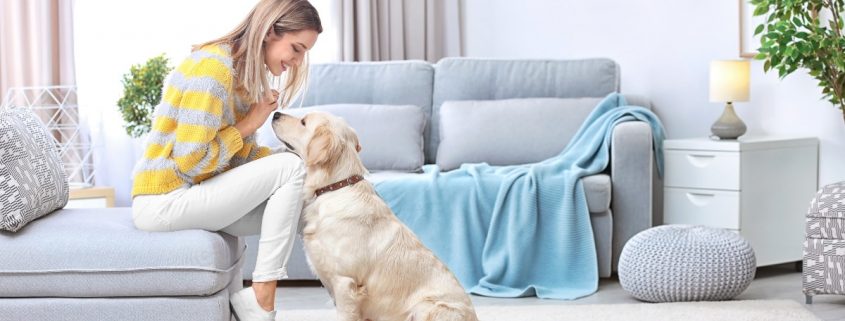Pets are like perpetual toddlers; they have the urge to explore and childlike energy that can sometimes lead to trouble. At home, pets can get trapped in tight spaces, fall downstairs, encounter cleaning chemicals, or eat any number of harmful items from socks to human medications.
Fortunately, many of these accidents are preventable with a few adjustments. When pet-proofing your home, it’s a fair assumption to think that nothing is safe when it comes to what your pets can get into. To help ensure your pet’s safety, it’s a good idea to take a holistic view of your home environment and identify any areas that may need some pet-proofing. In this blog, we guide you through the best ways to pet-proof your home room-by-room.
Home is Where the…Mischief is?
Whether it’s having a movie marathon or walking around in pajamas all day when we’re inside our home, we feel safe, cozy, and as if we can let our guard down. Pet parents, however, must remain alert and vigilant when it comes to ensuring their homes are safe for their puppy pals and feline friends. That way they can prevent an emergency before it has the chance to happen.
When pet-proofing your home please keep in mind that every pet is different. Your pet’s breed, age, and personality will all determine the extent of your pet-proofing needs. Now, let’s get started!
The Bedroom
Lounging around or snuggling up in bed with your best furry friend sounds great. But once you fall asleep, there’s a lot of potential for your furry friend to get into trouble.
- Start by picking up your stuff. Pets remind us of what we need to put away. If kids have toys on the floor, or you leave your favorite pair of sneakers laying out, dogs may discover them and use them as chew toys. This is bad news for your possessions, and a potential cause of obstructions in your pet’s stomach or intestines.
- Use a hamper with a lid. Your clothes smell like you, so it’s only natural that dogs and cats will want to get close to them. But when it goes beyond snuggling to chewing or swallowing, that dirty sock or pair of pants becomes a health risk. The best way to prevent this is to put clean clothes away, and place dirty clothes in a hamper that securely closes.
- Put makeup, perfume, and jewelry out of reach. These items should be high up or put away in a cabinet or drawer so they can’t be knocked over or eaten. Some makeup and perfumes can be toxic if ingested, while jewelry can cause obstructions or pose a choking hazard if swallowed.
The Bathroom
The bathroom is full of risks, from the temptations of the trash to sweet smelling cleaners.
- Buy a trash can with a secure lid. Opt for a trash can with a lid to prevent pets from digging in and eating used facial tissues, makeup sponges, diapers and so on.
- Lock up cleaners and toiletries. Toilet bowl cleaners and other tidying supplies should be locked away inside a cabinet. Scented items such as soaps and deodorants should be stored in a drawer or closet. Sometimes these sweet smelling products can attract pets, who may be tempted to chew or eat them. Bonus points are earned if you use child-proof locks on cabinets as an extra line of defense.
- Put the toilet seat down. Pets may be tempted to drink out of the toilet bowl, but be warned: Toilet bowl cleaners can be toxic, as most contain bleach.
Kitchen
Preventing pets from eating “human” food is one of the biggest priorities in this space–as everything we consume is not necessarily pet friendly.
- Store away food. Everyday foods such as chocolate, onions, and grapes are toxic to pets. Eating nontoxic human food can also be bad for a pet’s weight and can cause digestive upset.
- Take a second look at counters. If your cat is likely to leap up or your dog can reach high enough, you’ll need to be diligent about putting food away immediately after a meal and limiting the breakable items that stay on the counter.
Living Spaces
Your living room is where you—and, most likely, your pets—spend most of your time. That means there can be a huge hazard, depending on what is left out.
- Check your plants. Keep greenery that’s toxic to pets out of your home (the ASPCA has a searchable list). Even nontoxic plants should be out of nibbling distance to avoid vomiting and diarrhea.
- Review furniture placement and use anti-tip devices. Sometimes your feline friend might be feeling adventurous enough to climb up bookshelves or across tables. While doing so they may knock over decorative items, glassware, or in some cases the piece of furniture itself. For this reason, make sure that furniture is secure or isn’t an attractive climbing option.
- Tuck away cords and chargers. It’s also important to keep electric cords tucked away and out of reach. If your pet decides to chew them, the consequences could be deadly if they are plugged in.
Outside
So how the heck do you pet-proof the great outdoors? Your best bet may be to limit your pet’s access to outdoor spaces and keep a watchful eye. But if you’re looking to step up your game, the list below can be helpful.
- Store away toxic items. Antifreeze is highly toxic, as are gasoline and oil. Make sure these substances aren’t accessible and clean up spills promptly if they occur. Pesticides and herbicides should also be stored out of reach in spill-proof containers.
- Put away tools. You don’t want fishing lines, power tool cords or nuts and bolts laying out where pets may get tangled up or be tempted to chew on them.
- Check plants. If you are unsure of what bushes your landscaping consists of, or what flowers are blooming in your garden, it’s time to find out! You want to make sure the plants you put outside are nontoxic just as the ones you may have inside.
- Fence in the space. If you’re letting cats or dogs roam the yard, make sure it’s fenced in. This lessens the chance of them running off or encountering any unwelcome visitors (i.e. local wildlife or stray pets).
Your pets are our priority!
At the National Animal Supplement Council (NASC), our number one priority is to promote the health and wellbeing of your pets. That is why we created the NASC audit program and the Quality Seal, which helps you identify animal health and nutritional supplements that come from responsible suppliers committed to producing the highest quality, most consistent products available. Visit our website to learn more and to see a list of NASC members that have earned the Quality Seal.


